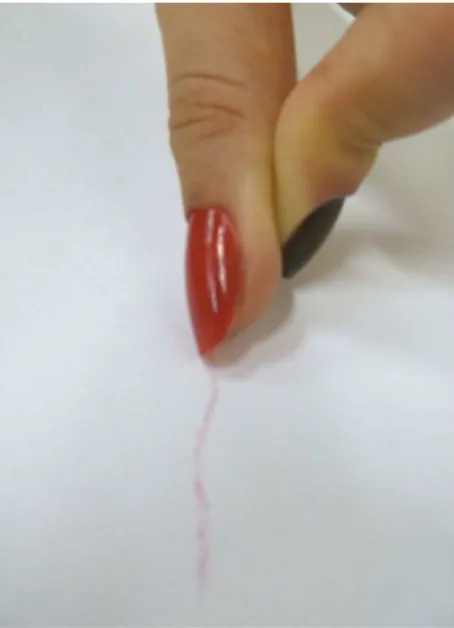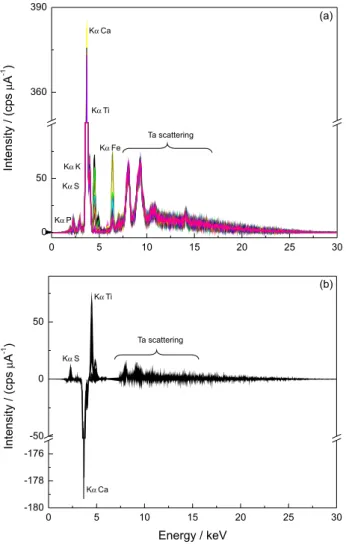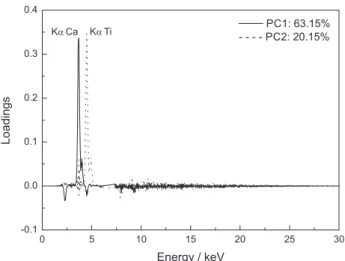Article
Printed in Brazil - ©2013 Sociedade Brasileira de Química0103 - 5053 $6.00+0.00A
*e-mail: bell@iqm.unicamp.br
Use of Portable X-ray Fluorescence to Discriminate Brands of Nail Polishes:
a Potential Forensic Tool
Gustavo G. Shimamoto, Juliana Terra and Maria Izabel M. S. Bueno*
Department of Analytical Chemistry, Institute of Chemistry, University of Campinas, CP 6154, 13083-970 Campinas-SP, Brazil
Em análise forense, uma pequena quantidade de um determinado material (cabelo, fibras, solo, vidro, pintura, entre outros) pode ser fundamental para elucidar a sequência de eventos em uma cena de crime ou para estabelecer a relação entre sujeitos e fatos. Existem vários exemplos de cosméticos usados como provas forenses, tais como batons e esmaltes de unhas. A composição desses esmaltes pode variar de acordo com a marca, cor e finalidade do produto. Neste trabalho, a classificação de esmaltes de unha brasileiros de acordo com a marca foi avaliada usando um espectrômetro portátil de fluorescência de raios X por energia dispersiva (EDXRF) e análise de componentes principais (PCA). A classificação não supervisionada das cinco marcas indica que a metodologia proposta pode ser uma alternativa rápida, de baixo custo e compatível com a química verde para discriminar marcas e outras características relacionadas a uma amostra de esmalte de unha, como possível evidência em cenas de crime.
In forensic analysis, a small quantity of a particular material (hairs, fibers, soils, glasses, paints, among others) can be important to elucidate the sequence of events in a crime scene or to establish the relationship among subjects and facts. There are several examples of cosmetics used as forensic evidences, such as lipsticks and nail polishes. The composition of nail polishes varies according to brand, color and purpose of the product. In this work, the separation of Brazilian nail polishes according to their brand was evaluated using a portable energy dispersive X-ray fluorescence spectrometer (EDXRF) and principal component analysis (PCA). The nonsupervised classification of five brands indicates that the proposed methodology may be a quick, low cost and green alternative to discriminate brands and other characteristics related to a nail polish sample, as possible evidence in crime scenes.
Keywords: X-ray fluorescence, portable XRF device, forensic chemistry, nail polish
Introduction
The search for traces at crime scenes is one of the several activities of forensic chemistry. Such traces are important as they can address issues of interest to the courts and even elucidate crimes.1,2 The main objective
of the investigation in a crime scene is to collect as many samples as possible that may be correlated to the offense, and to provide evidence to determine how the crime occurred. In this context, samples of hairs, fibers, soil particles, glasses, paint chips, blood and other human fluids may be of fundamental importance.3,4 Paint is a
typical example of a screening sample and is routinely analyzed by forensic laboratories worldwide. The analysis
of inkblots or paint flakes may provide evidence that correlates information to a person.5
There are several examples of colorings associated with cosmetics that can be forensic evidence, such as lipstick on collar of clothings and remnants of nail polish in garbage bags used to hide evidences of crime.6 Furthermore, when
writing a note, reading a book, turning on/off the light, or unintentionally rubbing the nail on surfaces like paper or walls, it is possible that these surfaces are stained with traces of nail polish (Figure 1).
use more nail polishes than men, there is an increasing trend in male use of personal care including nail products.
Nail polishes are products used to protect and beautify the fingernails, providing general brightness and color. Chemically, nail polishes are composed of a film former (15%), thermoplastic resin (7%), plasticizers (7%), solvent (70%), pigments (0-1%) and suspending agents (1%).8,9
The pigments present in nail polishes may cause spots on surfaces such as walls, papers or floor. In addition, pieces of painted nails found at crime scenes can provide details about the event under investigation. The nail polish color is clearly the primary evidence, but not the only one. Characteristics related to the components of this product may reveal not only the color but the manufacturer, thereby increasing the information about the possible individual related to the crime.10
Having all the above in mind, this work presents a proposal to use a portable X-ray fluorescence (XRF) spectrometer combined with chemometrics for grouping nail polish samples depending on their brands (manufacturer) as an useful evidence in forensic science. The colors are easily distinguishable; however, brands and various characteristics, such as elemental composition, are not. In this context, XRF and chemometrics were used.
XRF is a simple, fast and low operating cost technique and can be done in situ, using portable devices, now commonly
found around the world. Concurrently, the obtained XRF spectra can be treated with chemometric tools, enabling the classification of samples in a set of the same nature. Among such tools, principal component analysis (PCA) is the most popular, in which the dimensionality of the data set is reduced by linear combinations of the original variables, providing qualitative information that, among
other applications, allows grouping of samples according to their similarities.11,12
PCA is a nonsupervised procedure, or in other words, the modeling samples are not previously classified. In this case, the algorithm searches the data structure that allows grouping them.12
Experimental
Samples
In this study, forty two Brazilian nail polish samples of five different brands and several colors (red, blue, yellow, pink, brown, green and white) were used. All samples were purchased from stores in Campinas (São Paulo State, Brazil).
Method
The experiments were conducted using filter paper as surface support for the nail polish samples to simulate possible crime evidence. However, other surfaces and even a piece of painted fingernail could be also used.
For the measurements, a 5 cm2 filter paper was painted
with each sample. After 48 h, they were irradiated for 20 s. The instrument used was an energy dispersive X-ray fluorescence spectrometer cooled by a Peltier system, InnovX brand, model AlphaCam, provided with an X-ray tube with tantalum anode and a diode SiPIN detector. During sample irradiations, the voltage and current applied to the X-ray tube were 40 kV and 7 µA, respectively.
A blank paper without nail polish was also irradiated, and its spectrum was subtracted from each sample-paper spectrum.
PCA was performed using the Pirouette® software,
version 3.11. The spectra were mean centered to facilitate data visualization. This procedure involves the subtraction of the element of each column by the average value of the elements of that column, the result is a matrix in which all columns have zero mean.11,13,14 Besides this
preprocessing, the variables related to the Fe Kα and Kβ
lines were excluded to perform the procedures for PCA since iron oxides are used to produce brown pigment15 and
the concentration of Fe is directly linked to the color of the nail polish and that distinction is easily observed without chemometrics.
Results and Discussion
The X-ray spectra obtained for all samples are shown overlaid in Figure 2.
XRF is a multielemental technique that provides information related to the presence of elements with atomic numbers greater than 11. It is fast, requires minimal sample preparation, of low cost and does not require any reagent.13,16 Figure 2 shows clearly the presence of peaks
related to the elements P, S, K, Ca, Ti and Fe.
These peaks are primarily results of photoelectric effects. In other words, they are based on the energy released due to the electronic transition of the atoms of the sample when it is irradiated by high-energy electromagnetic radiation, causing the ejection of inner electrons (or photoelectrons). Both qualitative and quantitative information can be obtained simultaneously since each specific element releases characteristic energies in the process. Peak intensities are proportional to the amount of the specific element in the sample.17,18
In all the processes described above, a concomitant effect also occurs. It is known as the scattering process, with a greater preeminence for lighter elements, typical in organic matrices.19
In Figure 2, it is possible to find the presence of organic compounds in the analyzed nail polishes by observing the scattering of the tantalum lines, particularly in the region between 8 and 11 keV.
In the PC scores graph (Figure 3), a separation of the sample set into five main groups is observed. This separation is explained by principal components 1 and 2 (PC1 and PC2). The formed groups (represented by the symbols , , r, p and ) are the 5 nail polish brands (manufacturers) used. The application of external samples in the score graph can qualitatively indicate which brand this sample belongs to from its proximity to the other samples. For example, if an external sample displays PC1 score value 150 and PC2 score value −40, it can be inferred that the sample belongs to the brand r. If the PC1 and PC2 values are both zeros, brand identification is not so intuitive, but it can be inferred that this sample does not belong either to brand r or to .
The loading graph (Figure 4) identifies which variables in the spectral range are responsible for the formation of the principal components and hence for the observed separation: the Kα lines of calcium in PC1 and of titanium
in PC2.
Thus, the use of a multielemental technique such as XRF to generate the data, as well as multivariate analysis such as PCA tools to obtain a differentiation between brands, as done in this work, presents a new potential forensic analysis tool.
Titanium dioxide (TiO2) is widely used in the paint industry, especially as a white pigment, promoting stability and hiding power to the paint. Due to these and other characteristics, this compound is also present in Figure 2. Overlapping X-ray spectra of paper painted with different nail
polish samples, (a) before and (b) after subtracting the paper background.
papers, toothpaste, polymers and cosmetics such as nail polish.20 Despite its broad and wide application, TiO
2
has been characterized as a potentially carcinogenic substance.21 This should alert the supervisory agencies to
consider this parameter in quality control of the material, which is not routinely monitored nowadays.22
The high content of calcium in the nail polish can be related to the myth that higher amounts of calcium provide greater strength to the nail. van de Kerkhof et al.23 have
observed that instead of the calcium content, the sulfur concentration of the nail polish contributes more effectively in terms of cysteine disulfide bridges to stabilize proteins relevant to nail strength.23,24
There are some published works related to the research discussed here, however using more sophisticated techniques such as mass spectrometry,4,6 which often requires sample
preparation and reagents while generating waste. This proposal avoids such inconveniences, follows the principles of green chemistry, and can be performed at the crime scene, avoiding sample transportation, loss and contamination.
Identifying the brand of the nail polish found as a trace at a crime scene, or even the exclusion of one or two brands is clearly a good choice. Thus, the method here presented can help in investigations, restricting the number of suspects.
Conclusions
When finding a trace of nail polish on surfaces such as walls or paper, or even a piece of painted fingernail, the identification of the brand of nail polish can bring important findings during the investigation of a crime. XRF associated with chemometrics shows as a potential tool for discriminating nail polish brands on paper and analogous methods may extend to other surfaces such as walls, or
even a piece of painted fingernail. The principal component analysis applied to XRF spectra was able to group Brazilian brand nail polish samples and showed Ca and Ti Kα lines
as the most relevant ones to this task.
Acknowledgments
The authors thank the Coordenação de Aperfeiçoamento de Pessoal de Nível Superior (CAPES), Conselho Nacional de Desenvolvimento Científico e Tecnológico (CNPq) and Fundação de Amparo à Pesquisa do Estado de São Paulo (FAPESP) for supporting this work and Prof. Carol H. Collins and Dr. Ana Paula Espindola for English evaluation and valuable criticisms.
References
1. Romão, W.; Schwab, N. V.; Bueno, M. I. M. S.; Sparrapan, R.; Eberlin, M. N.; Martiny, A.; Sabino, B. D.; Maldaner, A. O.; Quim. Nova2011, 34, 1717.
2. De Oliveira, M. F.; QNEsc2006, 24, 17. 3. Bell, S.; Annu. Rev. Anal. Chem.2009, 2, 297.
4. Gresham, G. L.; Groenewold, G. S.; Bauer, W. F.; Ingram, J. C.; J. Forensic Sci.2000, 45, 310.
5. Roux, C.; Lennard, C.; Encyclopedia of Analytical Chemistry; John Wiley & Sons: New York, USA, 2006.
6. O’Neill, E.; Harrington, D.; Allison, J.; Anal. Bioanal. Chem.
2009, 394, 2029.
7. Chang, R. M.; Hare, A. Q.; Rich, P.; Dermatol. Ther.2007, 20, 54.
8. Favaro, P. C.; Bode, P.; De Nadai, E. A. F.; J. Radioanal. Nucl. Chem.2005, 264, 61.
9. Iorizzo, M.; Piraccini, B. M.; Tosti, A.; J. Cosmet. Dermatol.
2007, 6, 53.
10. Gordon, A.; Coulson, S.; J Forensic Sci. 2004, 49, 1.
11. Ferreira, M. M. C.; Antunes, A. M.; Melgo, M. S.; Volpe, P. L. O.; Quim. Nova 1999, 22, 724.
12. Beebe, K. R.; Pell, R. J.; Seasholtz, M. B.; Chemometrics: A Practical Guide, 1st ed.; John Wiley & Sons: New York, USA,
1998.
13. Shimamoto, G. G.; Kazitoris, B.; de Lima, L. F. R.; de Abreu, N. D.; Salvador, V. T.; Bueno, M. I. M. S.; de Castro, E. V. R.; Filho, E. A. S.; Romão, W.; Quim. Nova 2011, 34, 1389. 14. Terra, J.; Antunes, A. M.; Prado, M. A.; Bueno, M. I. M. S.;
Quim. Nova 2010, 33, 1098.
15. Bondioli, F.; Manfredini, T.; Oliveira, A. P. N.; Cerâmica Industrial1998, 3, 4.
16. Terra, J.; Antunes, A. M.; Prado, M. A.; Bueno, M. I. M. S.; X-ray Spectrom.2010, 39, 167.
17. Jenkins, R.; De Vries, J. L.; Practical X-ray Spectrometry, 2nd ed.; Springer: New York, USA, 1970.
18. Skoog, D. A.; Holler, F. J.; Nilman, T. A.; Princípios de Análise Instrumental, 5ª ed.; Bookman: Porto Alegre, Brasil, 2002. 19. Jenkins, R.; X-Ray Fluorescence, 2nd ed.; Wiley-Interscience:
New York, USA, 1999.
20. Peixoto, E. M. A.; QNEsc2006, 23, 54.
21. Schwab, N. V.; Da-Col, J. A.; Terra, J.; Bueno, M. I. M. S.; J. Braz. Chem. Soc2012, 23, 546.
22. Terra, J.; Shimamoto, G. G.; Forchetti, D. A. P.; Bueno, M. I. M. S.; resumo da 35a Reunião Anual da Sociedade
Brasileira de Química 2012, Águas de Lindoia-SP, ANA 109. http://sec.sbq.org.br/eventos/35ra/resumos/T0918-1.pdf accessed in February 2013.
23. van de Kerkhof, P. C. M.; Pasch M. C.; Scher, R. K.; Kerscher, M.; Gieler, U.; Haneke, E.; J. Am. Acad. Dermatol.
2005, 53, 644.
24. Costa, I. M. C.; Nogueira, L. S.; Garcia, P. S.; An. Bras. Dermatol. 2007, 82, 263.
Submitted: November 13, 2012
Published online: April 17, 2013


